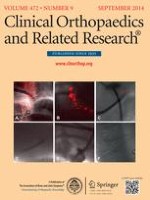Published in:

01-09-2014 | Symposium: Management of the Dislocated Knee
Is Peroneal Nerve Injury Associated With Worse Function After Knee Dislocation?
Authors:
Aaron J. Krych, MD, Steven A. Giuseffi, MD, Scott A. Kuzma, MD, Michael J. Stuart, MD, Bruce A. Levy, MD
Published in:
Clinical Orthopaedics and Related Research®
|
Issue 9/2014
Login to get access
Abstract
Background
Peroneal nerve palsy is a frequent and potentially disabling complication of multiligament knee dislocation, but little information exists on the degree to which patients recover motor or sensory function after this injury, and whether having this nerve injury–with or without complete recovery–is a predictor of inferior patient-reported outcome scores.
Questions/purposes
The purposes of this study were to (1) report on motor and sensory recovery as well as patient-reported outcomes scores of patients with peroneal nerve injury from multiligament knee dislocation; (2) compare those endpoints between patients who had partial versus complete nerve injuries; and (3) compare patient-reported outcomes among patients who sustained peroneal nerve injuries after knee dislocation with a matched cohort of multiligament knee injuries without nerve injury.
Methods
Thirty-two patients were identified, but five did not have 2-year followup and are excluded (16% lost to followup). Twenty-seven patients (24 male, three female) with peroneal nerve injury underwent multiligament knee reconstruction and were followed for 6.3 years (range, 2-18 years). Motor grades were assessed by examination and outcomes by International Knee Documentation Committee (IKDC) and Lysholm scores. Retrospectively, patients were divided into complete (n = 9) and partial nerve palsy (n = 18). Treatment for complete nerve palsy included an ankle-foot orthosis for all patients, nonoperative (one), neurolysis (two), tendon transfer (three), nerve transfer (one), and combined nerve/tendon transfer (one). Treatment for partial nerve palsy included nonoperative (12), neurolysis (four), nerve transfer (one), and combined nerve/tendon transfer (one). Furthermore, patients without nerve injury were matched by Schenck classification, age, and sex. Data were analyzed using univariate and multivariate models.
Results
Overall, 18 patients (69%) regained antigravity ankle dorsiflexion after treatment (three complete nerve palsy [38%] versus 15 partial nerve palsy [83%]; p = 0.06). One patient with complete nerve palsy (13%) and 13 patients with partial nerve palsy (72%) regained antigravity extensor hallucis longus strength (p = 0.01). IKDC and Lysholm scores were similar between complete nerve palsy and partial nerve palsy groups. After controlling for confounding variables such as patient age, body mass index, injury interval to surgery, mechanism of injury, bicruciate injury, and popliteal artery injury status, there was no difference between patients with peroneal nerve injury and those without on Lysholm or IKDC scores.
Conclusions
With multiligament knee dislocation and associated peroneal nerve injury, patients with partial nerve injury are more likely to regain antigravity strength when compared with those with a complete nerve injury, but their overall function may not improve. After controlling for confounding variables in a multivariate model, there was no difference in Lysholm or IKDC scores between patients with peroneal nerve injury and those without.
Level of Evidence
Level III, therapeutic study. See Guidelines for Authors for a complete description of levels of evidence.